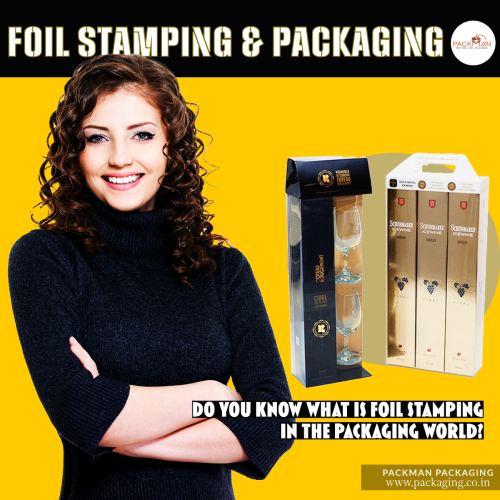When it comes to making a lasting impression, packaging plays a pivotal role in capturing the consumer’s attention. Among the myriad of techniques used in the world of packaging design, foil stamping stands out as a timeless and elegant embellishment. This process not only adds a touch of luxury but also communicates quality and sophistication.
This article, from Packman Packaging India’s top manufacturer of corrugated boxes, takes us to see the fascinating world of foil stamping in packaging, exploring what it is, how it works, and its significance in branding and marketing.
What is foil stamping?
Mr. Gaurav Jalan, Founder and CEO of Packman Packaging explains the foil stamping:
Understanding Foil Stamping
Foil stamping, also known as foil printing or hot stamping, is a decorative finishing process widely used in the packaging industry. It involves the application of metallic or coloured foil onto the surface of paper, cardboard, plastic, or other materials. The result is a visually striking and tactile effect that enhances the overall aesthetics of the packaging.
The Foil Stamping Process
The foil stamping process is a meticulous and precise craft that requires skill and expertise. Here’s a step-by-step breakdown of how it works:
- Design Preparation: The process begins with the creation of a design or pattern that needs to be foiled. This design is typically in the form of text, graphics, or intricate patterns.
- Die-Cutting: A metal die or stamping die is created based on the design. This die serves as a mold for the foil to adhere to. The die is heated to a specific temperature, ensuring proper adhesion of the foil.
- Foil Feeding: A roll of metallic or coloured foil is fed through a machine, which advances it to the point where it will be stamped onto the packaging material.
- Stamping: The packaging material, often flat sheets or rolls, is placed beneath the heated die. Pressure is applied to the die, causing the foil to transfer from the roll onto the packaging material. The heat, pressure, and dwell time must be carefully controlled to ensure a precise and consistent result.
- Cooling and Release: After the foil has been stamped onto the packaging material, it’s allowed to cool and set. Once cooled, the packaging material is separated from the die, leaving behind the foiled design.
Benefits of Foil Stamping in Packaging
- Luxurious Appearance: Foil stamping adds an air of luxury and opulence to packaging. The shimmering, metallic finish catches the eye and conveys a sense of premium quality.
- Customization: Foil stamping allows for a high degree of customization. Brands can choose from a wide range of foil colours, including metallic, matte, and holographic options, to create packaging that aligns perfectly with their brand identity.
- Durability: Foil-stamped packaging is more durable and resistant to wear and tear compared to printed designs. This ensures that the packaging maintains its visual appeal throughout its journey from production to the hands of consumers.
- Brand Recognition: Foil-stamped logos and branding elements make a lasting impression on customers. This helps in brand recognition and reinforces the brand’s image as one of quality and attention to detail.
- Emotional Appeal: Foil stamping evokes an emotional response in consumers, making them more likely to engage with and remember the product. This can lead to increased sales and customer loyalty.
Applications of Foil Stamping
Foil stamping is a versatile technique that can be applied to a wide range of packaging materials and products. It is commonly used in:
- Cosmetics and Beauty Products: Foil-stamped logos and designs are frequently seen on high-end cosmetics and skincare packaging.
- Food and Beverage Packaging: Premium chocolates, wines, and spirits often feature foil-stamped labels and packaging to communicate exclusivity and quality.
- Luxury Apparel and Accessories: Foil stamping adds an extra layer of sophistication to clothing tags, shoeboxes, and accessory packaging.
- Corporate Materials: Business cards, brochures, and presentation folders benefit from foil stamping to make a strong impression in corporate settings.
In conclusion, foil stamping is a powerful tool in the world of packaging design. Its ability to transform ordinary packaging into a visually captivating and emotionally resonant experience makes it a valuable asset for brands seeking to stand out in a competitive market. By incorporating foil stamping into their packaging, businesses can elevate their products and leave a lasting imprint on consumers’ minds. Foil stamping isn’t just a process; it’s an art that turns packaging into a work of visual and tactile wonder.





